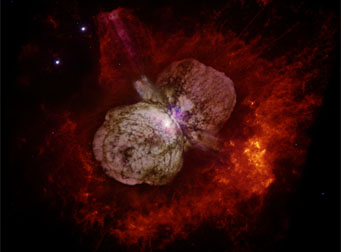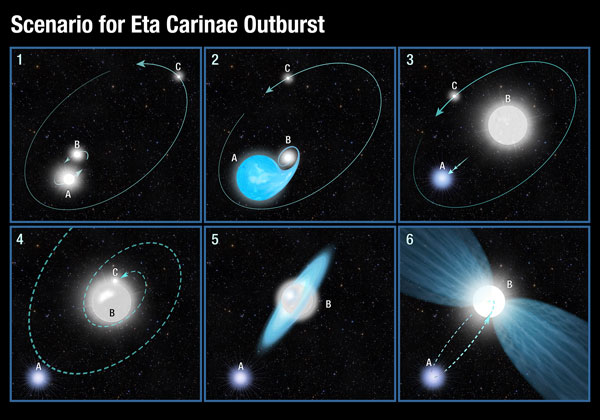Faint echoes of light illuminate what really happened during the Great Eruption of the super-star Eta Carinae.

NASA / ESA / Nathan Smith (University of California, Berkeley)
A nasty case of sibling rivalry may have caused an explosion in the massive star system known as Eta Carinae. New analysis of "light echoes" backs up a theory that the system initially had three stars — but in a plot reminiscent of Game of Thrones, only two stars survived.
Eta Carinae experienced a major explosion known as the Great Eruption 170 years ago, witnessed worldwide as the primary star suddenly became the second-brightest star in the night sky. It resembled a supernova in ferocity, but somehow left the primary, uber-massive star intact. Now, a pair of studies appearing in the Monthly Notices of the Royal Astronomical Society (paper 1, paper 2) has tracked down the faint echoes of light reflecting off of nearby interstellar dust, giving astronomers a real-time view of the long-ago goings-on.
By taking the spectrum of this reflected light, Nathan Smith (University of Arizona) and colleagues could essentially look back in time, measuring how quickly material sped along during the stellar explosion. Because light has a finite speed, examining the light echoes in different regions of dust enabled the team to track debris for a long timeframe during the explosion. "It's like going back and investigating the crime scene with modern instruments," Smith says.
To the astronomers' surprise, they saw that the spectrum’s properties changed dramatically in light echoes that recorded the events of the 1840s and 1850s. The data showed that the explosion reached speeds of millions of miles per hour.
Examining a Light Echo
A massive star sending out a strong flow of material often shows emission lines in its spectrum, Smith explains. If the outflow is slow, those lines appear narrow, but a fast outflow will smear the lines, broadening them. In addition, because the light echoes are showing us light emitted 170 years ago, the spectra show changes from that long-ago eruption in real-time.
The spectra showed that the speed of the outflow changed several times over the decade of the Great Eruption. At first, the outflow speed was between 150 km/s and 200 km/s (340,000 mph and 450,000 mph). Then the speed of the material increased to the current expansion rate of 600 km/s and higher, with multiple streams of particles moving at speeds up to 1,000 km/s.
"But that's not the real whopper," Smith continues. In the second phase, his team saw that the wind accelerated to very high speeds, but unevenly. The explosion was asymmetric. The winds moving toward Earth reached an incredible 10,000 km/s (22.3 million mph), but those winds moving away from Earth were even faster, whooshing out at 20,000 km/s.
These high speeds are indicative of a shock wave following a massive explosion, Smith said. "This is an extremely important new observation, and fundamentally changes what we think is the nature of the explosion," he added.
Sibling Rivalry
How did this happen? The team's strongest scenario suggests a violent interaction between three stars.

NASA / ESA / and A. Feild (STScI)
The story of this star system itself is complicated, involving millions of years of evolution in which some of the siblings swapped gas and even switched orbits. At first, two stars – let's call them A and B – were orbiting each other close in, while a third star – let’s call it C – orbited further out. As A reached the end of its life, it lost its outer layers, transferring mass to B in the process and leaving behind a helium-rich core. Meanwhile B, already a hefty star, grew to at least 100 times the Sun’s mass.
This mass transfer moved the system’s center of mass toward B, pushing A farther out, where it began to pull on C. In the gravitational interaction, A and C swapped places: now C and B were close in to each other and A farther out. Their mutual orbit wasn’t stable and C and B merged, releasing the tremendous amount of energy seen in the Great Eruption. Stars A and B still orbit each other today, with a period of 5.5 years.
According to the scenario that Smith’s team is proposing, the "slow" outflow phase seen in the light echoes corresponds to when C and B were spiraling in toward each other, shedding mass as they went. By the time the two stars merged, a cocoon of dense, slowly expanding material surrounded them. The merger triggered the explosion, sending stellar material, accelerated to high speeds, slamming into the surrounding cocoon and producing the multiple debris speeds astronomers spotted in the light echoes’ second, faster phase.
Edward van den Heuvel (University of Amsterdam), who co-wrote a 2016 paper that also suggested a triple-star framework, says the new studies improve on his model, because they’re largely better in tune with Eta Carinae’s observed characteristics. However, he notes that in his model, the initial companion star (A) is an ordinary O-type star, while Smith’s calculations require that companion to be a Wolf-Rayet star. While O stars are relatively common, Wolf-Rayet stars are short-lived and therefore more rarely found.
Smith says the team plans to further observe the star system for additional light echoes, to see if they can find any more information about the explosion's evolution.
 4
4









Comments
Frank-ReedNavigation.com
August 9, 2018 at 3:30 pm
You wrote that the Great Eruption was "witnessed worldwide". Around the globe in longitude, yes, but Eta Car was/is visible in the southern hemisphere and up to about 26° N (for a max altitude of at least 5°). Even in the 1840s that means that less than half of the world's population could have seen it, and maybe a quarter of the global population would have had a clear view.
It's interesting to speculate how how such a spectacle would have affected the apprehensions of a superstitious world if it had been visible in mid-northern latitudes. Only ten years after the Leonid meteor shower famously startled, and in some cases terrified, the population of the USA, if a star suddenly erupted in brilliance peeking ten years after the Leonids, what message would have been sought in the skies?
You must be logged in to post a comment.
Anthony Barreiro
August 10, 2018 at 10:08 pm
Thanks very much for this clear and interesting report. The figure and video are helpful. I would be interested to see spectra, I think that might help me understand the light echoes better. It looks like you meant to include links to the MNRAS papers, but I only see placeholders, not active links.
You must be logged in to post a comment.
Monica Young
August 11, 2018 at 6:26 am
Thanks, Anthony, I've updated those placeholders with active links!
You must be logged in to post a comment.
Anthony Barreiro
August 13, 2018 at 3:53 pm
Thanks Monica. The spectra figures in "paper 1" describe the light echoes in more detail.
After skimming through both papers, I am even more impressed with how Elizabeth's article makes this stuff intelligible to the general reader.
You must be logged in to post a comment.
You must be logged in to post a comment.